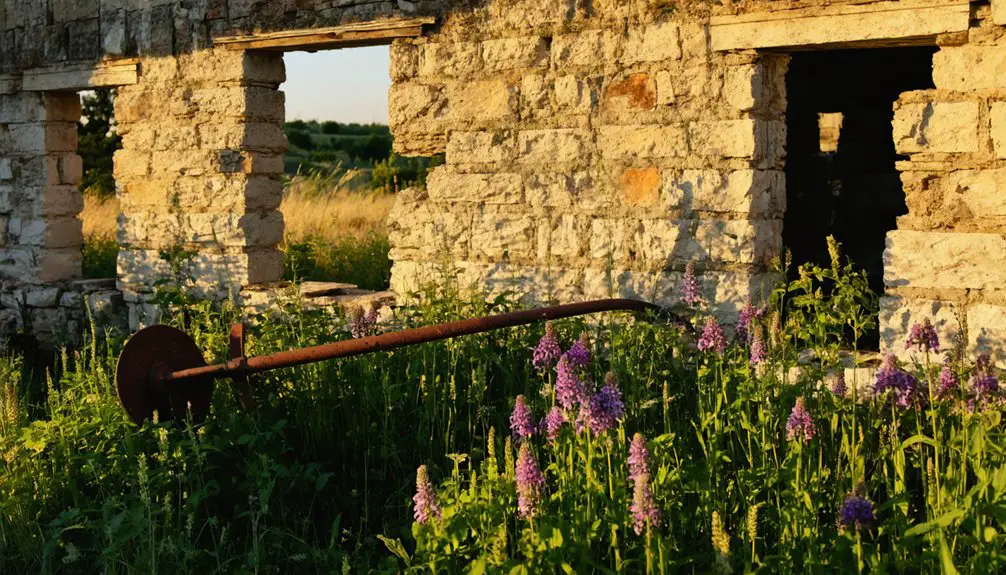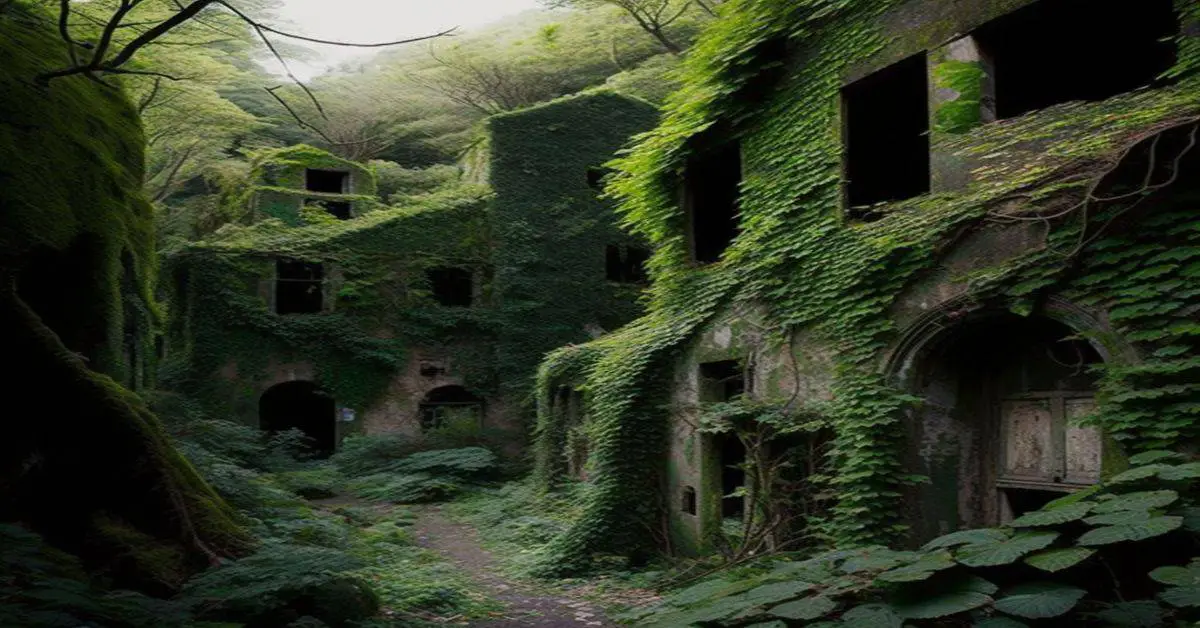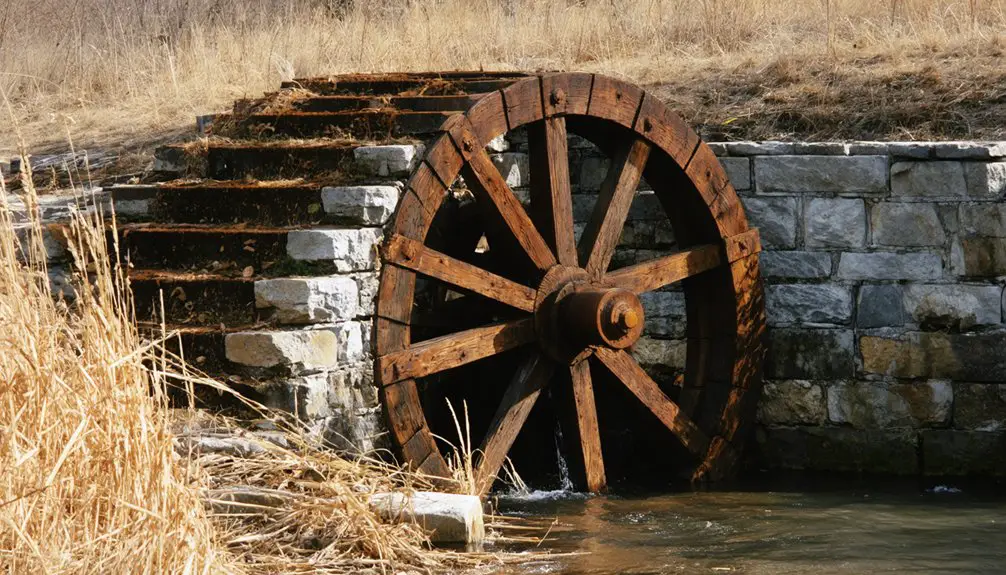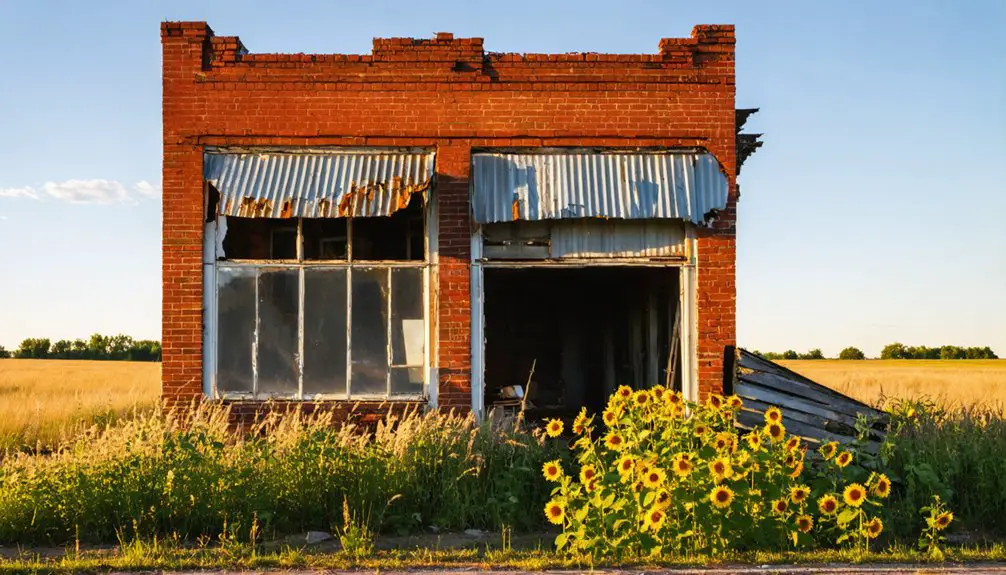You’ll find Minersville’s remains six miles north of Concordia, Kansas, where Heim Nelson’s 1869 coal discovery sparked a vibrant mining settlement. The town flourished in the 1870s-1890s, with Alexander Henderson’s three mine shafts producing up to 13,000 tons annually. Miners earned $1.50-$2 per ton while living in dugouts, while owners occupied stone houses. Today, weathered limestone buildings and abandoned mine shafts tell the story of this once-thriving community’s rise and mysterious decline.
Key Takeaways
- Minersville, Kansas emerged as a coal mining town in 1869 after Heim Nelson discovered lignite deposits near northern Cloud County.
- The town flourished in the 1870s-1890s with three mine shafts, two churches, and a diverse community of miners and their families.
- Mining operations peaked in 1894-1895, producing over 13,000 tons of coal before the town’s eventual decline.
- Stone houses, collapsed dugouts, and abandoned mine shafts remain as physical evidence of the former mining settlement.
- The ghost town’s remnants include weathered limestone buildings and strip mine scars, now subject to preservation efforts.
From Coal Discovery to Frontier Settlement
While coal had been found across Kansas in the late 1800s, the discovery of a lignite vein near northern Cloud County in 1869 by Heim Nelson marked the beginning of Minersville’s story. This low-grade, brown coal lay just beneath the prairie surface, buried under sandstone and containing 25-40% carbon.
You’ll find that coal mining quickly transformed this frontier settlement into a bustling town by the early 1870s. Located six miles north of Concordia, Minersville demonstrated remarkable community resilience as settlers like Scottish immigrant Alexander Henderson combined farming with mining to survive. The Henderson family proved instrumental in the town’s growth, establishing three mine shafts by 1882. Workers at the mines earned between $1.50 to $2 per ton for their labor.
The town grew to include essential services: a store, school, boarding house, and two churches. Despite lignite’s lower efficiency compared to other coal types, its accessibility proved vital for settlers in this wood-scarce region.
Life in a Kansas Mining Community
Though life in Minersville demanded resilience, you’ll find that residents built a close-knit community centered around mining culture.
You’d see miners living in modest dugouts carved into hillsides, while mine owners occupied stone houses that reflected the town’s social hierarchy. The community dynamics revolved around two churches, baseball teams, and community bands, where social gatherings provided essential relief from grueling underground work. Room-and-pillar systems were commonly used for extracting coal from the mines.
You’d discover a self-contained town with general stores, schools, and boarding houses for transient workers. The town’s immigrant population included Italians and Austrians, creating a vibrant multicultural atmosphere.
While men spent long hours in coal shafts 25 to 75 feet deep, their families created stability through local institutions. The town’s economy depended entirely on mining success, with workers often following job opportunities from one mine to another, creating a diverse, largely male population that shaped Minersville’s character.
The Rise and Fall of Local Coal Mining
The discovery of coal deposits by Heim Nelson in 1869 marked the beginning of Minersville’s mining era.
You’d find miners using primitive mining techniques, descending into shafts 20-80 feet deep on boards suspended by horse-operated pulleys. The extracted lignite coal, though lower in quality with 25-40% carbon content, supported local energy needs.
Miners braved deep shafts on horse-drawn pulley systems, extracting vital lignite coal despite its lower carbon content.
Mining operations peaked in 1894-1895, yielding over 13,000 tons across Cloud and Republic Counties.
Economic factors shaped the town’s development, with mine owners investing in stone buildings and infrastructure. The industry provided essential seasonal employment for local farmers during agricultural off-seasons. The town supported the mining community with two local churches, offering miners and their families a place for spiritual gathering.
Daily Struggles and Triumphs of Minersville Residents
Living in Minersville meant enduring stark social divisions between mine owners and workers during the late 1800s. While owners resided in stone houses, you’d find most miners dwelling in dugouts carved into hillsides.
Yet community resilience emerged through shared institutions – two churches, a school, and the Knights of Labor lodge hosted cultural events that united residents across class lines.
You’d witness remarkable economic adaptation as families balanced mining with farming to survive. During growing seasons, they’d work their fields, then descend 25 to 75 feet into mine shafts during off-seasons. Similar to Bell Plane’s economy, agriculture remained vital to sustaining local families.
Despite burning dirty lignite coal for heat and facing constant employment uncertainty, Minersville’s residents built a vibrant community life. They formed baseball teams, played in the town band, and gathered at the local store, finding strength in their collective determination. People would travel up to 100 miles to collect coal from the mines for their steam engines and home heating needs.
What Remains: Traces of a Vanished Town
Standing amid Minersville’s ruins today, you’ll find a ghostly collection of weathered limestone buildings with hollow windows and deteriorating roofs – stark remnants of what was once a bustling mining community.
Through careful ruins exploration, you can trace the town’s history in its surviving stone houses built by mine owners, while collapsed dugouts mark where miners once lived. Like many ghost town relics across America, these structures tell stories of economic booms and dramatic busts.
Crumbling stone mansions and earthen depressions tell a tale of social divide in this abandoned mining settlement.
- Hidden cellar walls protect forgotten artifact caches, revealing untold stories of post-abandonment activities
- Abandoned mine shafts, now mostly collapsed, pierce the earth 20-80 feet deep
- Strip mine scars alter the landscape, though nature slowly reclaims them
- Original wagon paths still wind through the prairie, connecting forgotten mine sites
Archaeological surveys and preservation efforts, led by researchers like Debi Aaron, guarantee these physical traces of Minersville’s mining heritage won’t be lost to time.
Frequently Asked Questions
What Happened to the Children Who Grew up in Minersville?
Like scattered coal dust, your childhood memories paint tales of lost generations who migrated away after 1945’s mine closures, seeking education and work opportunities in neighboring Kansas towns.
Were There Any Major Mining Accidents or Deaths Recorded?
Historical records show one confirmed mining death from 1891 when a miner was crushed by falling stone. While mining safety was poor, you’ll find no evidence of major disasters in Minersville’s mines.
How Did Severe Weather and Natural Disasters Affect the Mining Operations?
You’ll find weather impact severely disrupted mining through flooded shafts, frozen equipment, and unstable ground conditions. Disaster recovery efforts were limited, with storms damaging infrastructure and restricting coal transportation year-round.
What Native American Tribes Originally Inhabited the Minersville Area?
You’ll find the Pawnee and Kansa (Kaw) were the primary Native tribes in Minersville’s region, using the area for seasonal hunting. Historical records show Shawnee and Sac & Fox influence nearby.
Did Any Ghost Stories or Local Legends Emerge From Minersville?
While there aren’t documented ghost sightings, you’ll find local folklore centered on a miner’s lead dollar forgery scheme and tales of hardship from the dangerous mines and abandoned dugouts.
References
- https://www.humanitieskansas.org/get-involved/kansas-stories/places/mining-for-stories-in-a-kansas-ghost-town
- https://krex.k-state.edu/bitstream/handle/2097/41036/250c064ae314662b16d5099ef8b205ee.pdf?sequence=1
- https://kclyradio.com/education/documentary-on-forgotten-mining-town-of-minersville-to-screen-saturday-at-cloud-county-museum/
- https://legendsofkansas.com/minersville-kansas/
- https://www.travelks.com/kansas-magazine/articles/post/a-coal-mine-on-the-plains/
- https://www.kgs.ku.edu/Publications/Bulletins/32/index.html
- https://bladeempire.com/stories/minersville-documentary
- https://www.kancoll.org/khq/1972/72_2_powell.htm
- https://legendsofkansas.com/coal-mining-in-kansas/
- https://geokansas.ku.edu/coal-mining



